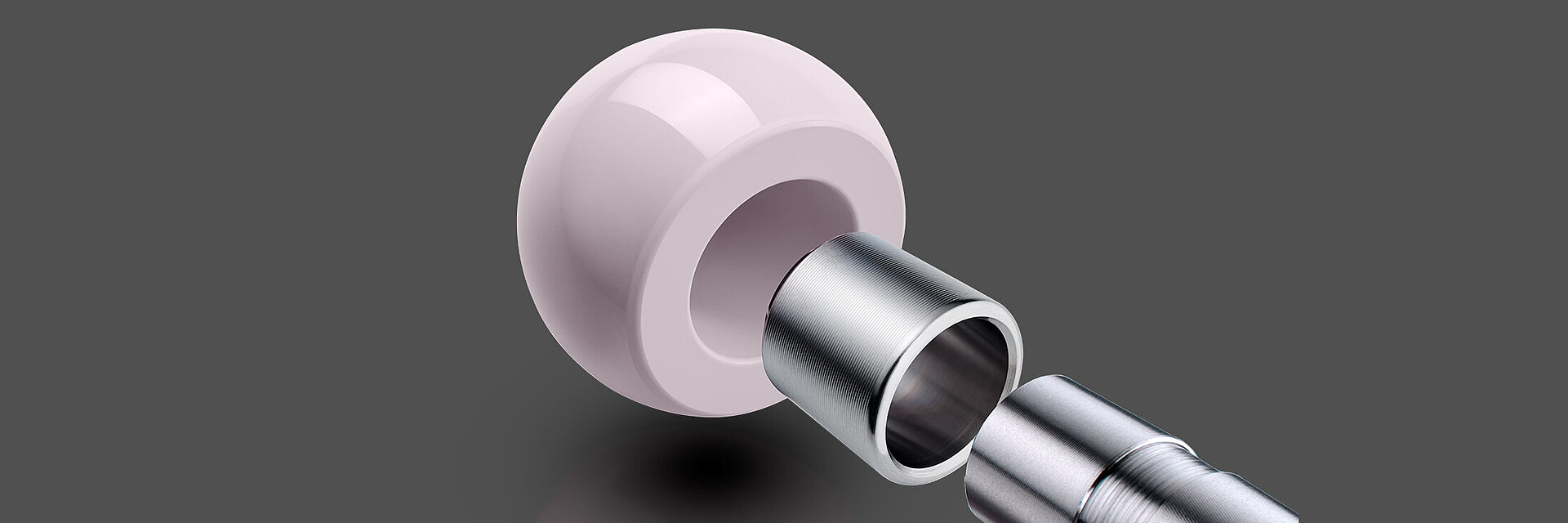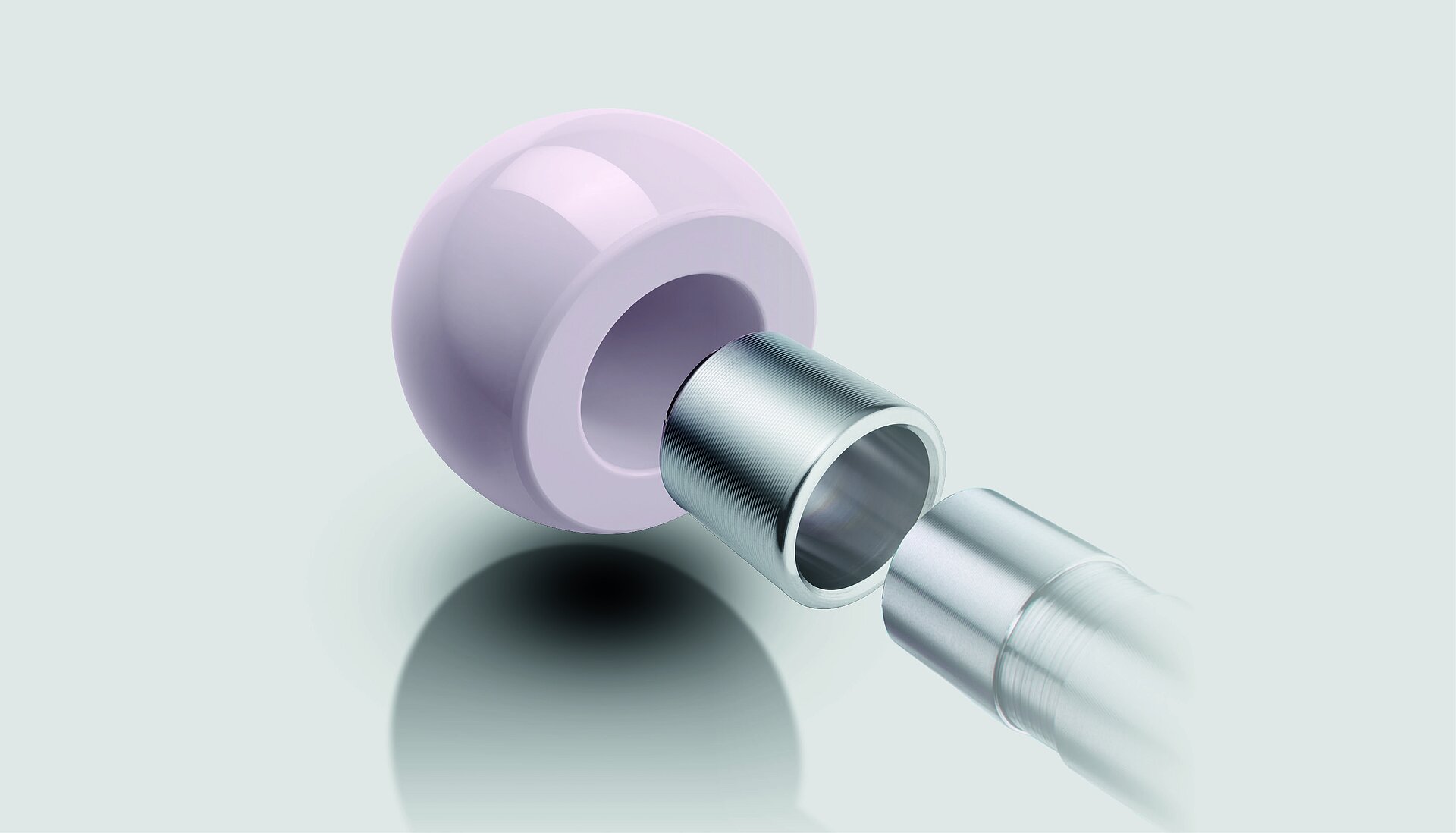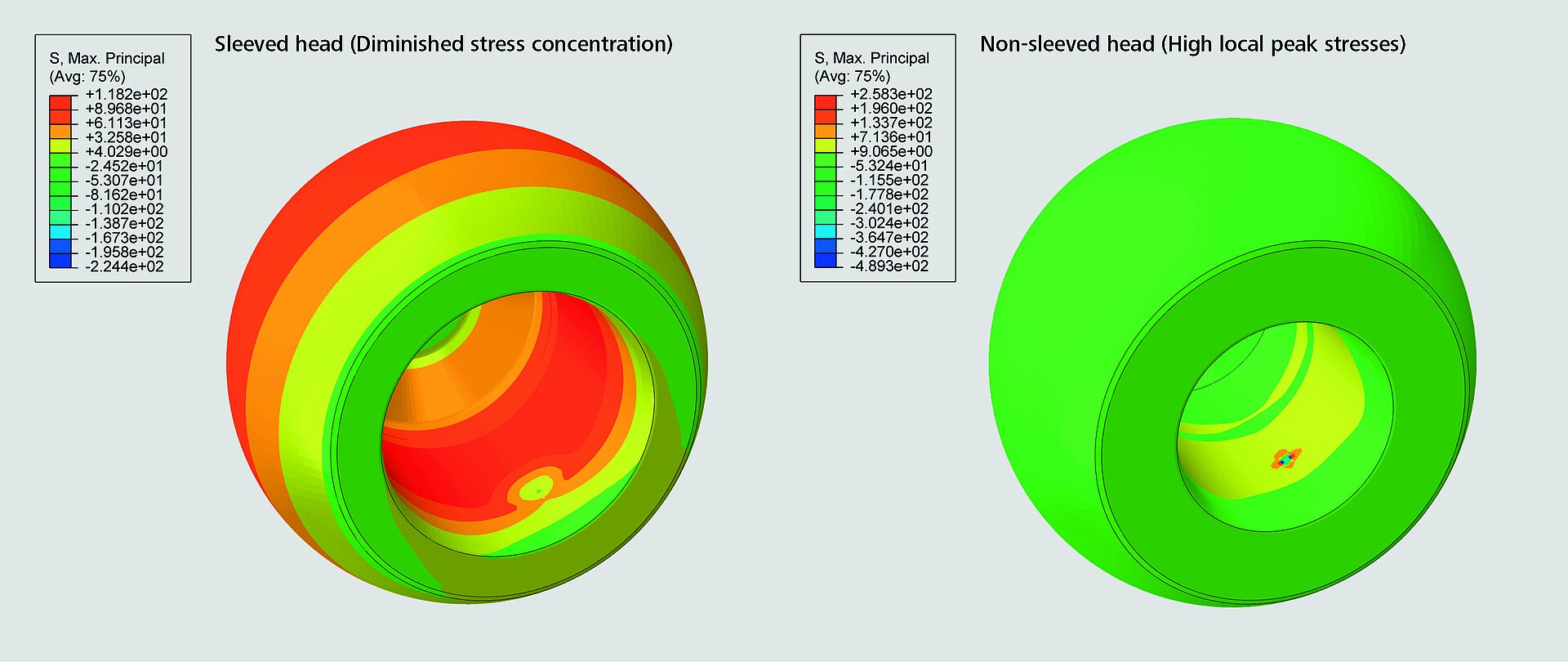Sleeved Ceramic Heads: Versatile, Essential and Proven
Sleeved femoral heads made of BIOLOX®delta ceramic were introduced in 2005 with the brand name BIOLOX®OPTION. They offer the possibility of adjusting offset intraoperatively, but also revising a femoral head implant while retaining a well-fixed femoral stem with minor damages on the taper surface. The adapter sleeve was designed to create a pristine taper interface for the ceramic head before it is placed on a stem which remains in situ. Recent publications offer additional evidence on the protecting role of the sleeve.
Restoring the interface
In hip revision, the metal taper of an otherwise intact and well-fixed stem can exhibit varying types of damage: scratches, scars, flattened or burnished areas which may be attributed to assembly or disassembly damage as well as black debris indicating fretting or even corrosion1. Depending on the grade of the taper damage, the use of a sleeved ceramic head can offer a possibility to retain a well-fixed stem.
The surface of a metal taper is manufactured with a special structure for optimal stress distribution. The adapter sleeve is intended to restore a pristine interface on its outer and to compensate slight damages on its inner side, to enable a secure head-taper lock and to avoid rotation of the new ceramic head.
Recent findings with BIOLOX®OPTION
Chaudhary et al.2 from the Massachusetts General Hospital in Boston investigated the pull-off strength and seating displacement of BIOLOX®delta femoral heads and titanium taper sleeves. Two head diameters and two sleeve offset lengths were mated with trunnions at two different impaction forces. The sleeved heads showed a fixation strength similar to values published for non-sleeved heads. The pull-off force increased linearly with the assembly force as well. The head diameter did not have a significant effect on the measured parameters. Compared to short offset length, extra-long sleeves showed lower pull-off forces, particularly at higher impact forces. The authors confirmed that this may potentially result in better clinical outcomes by mitigating fretting corrosion.
Prof. Morlock's research group at the Technical University of Hamburg (TUHH) investigated the impact of stem taper damage on the fracture strength of sleeved ceramic heads. For this purpose, Dickinson et al.3 compared the fracture resistance of sleeved BIOLOX®delta heads while Falkenberg et al.4 simulated the fracture resistance of sleeved heads and compared them with non-sleeved BIOLOX®delta heads after impaction on severely damaged tapers.4 Four categories of severe taper damage were reproduced:
a. Truncated
b. Slanted
c. Crushed
d. Scratched
NOTE: With an already used stem taper, the surgeon has to make sure that the form of the taper remains unchanged and inspect it for damages such as severe abrasion/material loss, elevations and/or deep scratches ...
The categories of deformation reproduced at the TUHH are considered by manufacturers as unacceptable. Therefore, the use of sleeved BIOLOX®delta heads on such tapers is not allowed.
In both studies, the fracture strength of sleeved BIOLOX®delta heads measured with all investigated stem taper damage types was several times higher than the fracture force required by FDA recommendations. The heads were subjected to the ISO 7206-10 standard ultimate compression test, which is far from physiological loadings. The fixation strength of the taper junction depends on multiple factors which may vary in the clinical setting such as head diameter, assembly force and the angle, length and surface roughness of the taper. All these factors may influence the stress distribution and other conditions as the contamination junction5.
Uncompromised taper shape required
The unpredictability of these factors supports the manufacturer guidelines, which do not allow the implantation of sleeved heads in the extreme conditions tested in this study. Therefore, the surgeon must make sure that the shape of the taper is not compromised due to damage, such as severe wash-out areas, severe abrasion, material loss, deep scratches and ridges or similar defects.
The numerical simulations4 showed comparable fracture forces for truncated, slanted and crushed tapers for both sleeved and non-sleeved heads. However, the investigation showed that small local metal elevations at the edge of a scratch or at a surface damage can lead to early failure of non-sleeved ceramic heads despite their high fracture strength. Indeed, high local stress peaks generated by a small metal elevation (“scratch”) drastically reduced the fracture strength of non-sleeved heads (−96%), whereas sleeved heads remained unaffected.
CeramTec is committed to selecting and bringing to interested parties relevant articles on bioceramics related topics. The presented authors’ views and opinions are solely those of the authors of these publications. It is the focus and intent of CeraNews that CeramTec presents and comments on the authors’ views and opinions in a specific context. Such comments and editorials therefore solely express CeramTec’s views and opinions and not necessarily those of the quoted authors.
References
- Goldberg JR, Gilbert JL, Jacobs JJ, Bauer TW, Paprosky W, Leurgans S. A multicenter retrieval study of the taper interfaces of modular hip prostheses. Clin Orthop Relat Res. 2002;401:149-161.
- Chaudhary M, Boruah S, Muratoglu OK, Varadarajan KM. Evaluation of pull-off strength and seating displacement of sleeved ceramic revision heads in modular hip arthroplasty. J Orthop Res. 2019. doi:10.1002/jor.24536.
- Dickinson EC, Sellenschloh K, Morlock MM. Impact of stem taper damage on the fracture strength of ceramic heads with adapter sleeves. Clin Biomech (Bristol, Avon). 2019;63:193-200. doi:10.1016/j.clinbiomech.2019.03.005.
- Falkenberg A, Dickinson EC, Morlock MM. Adapter sleeves are essential for ceramic heads in hip revision surgery. Clin Biomech (Bristol, Avon). 2020;71:1-4. doi:10.1016/j.clinbiomech.2019.10.018.
- Porporati AA, Upmann C, Pandorf T. What is the influence of taper contamination on the burst strength of alumina matrix composite ball heads? Efortnet website. https://efortnet.efort.org/group/elibrary/. Accessed April 8, 2020.



